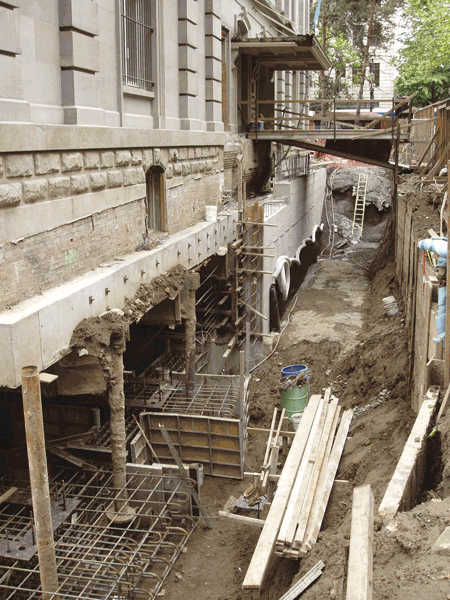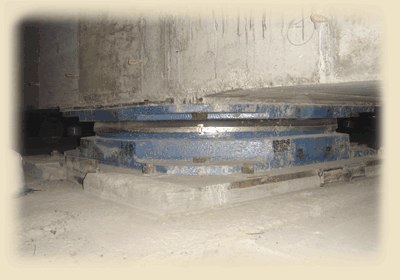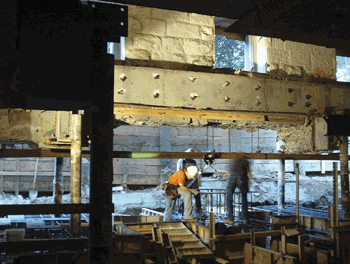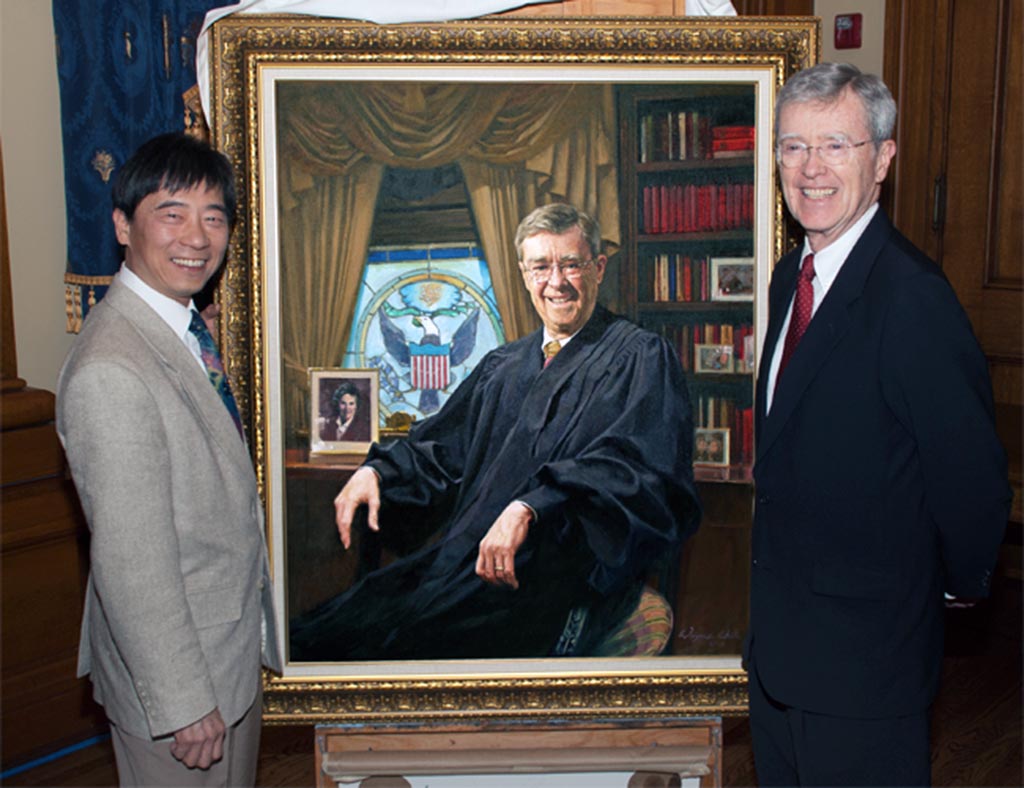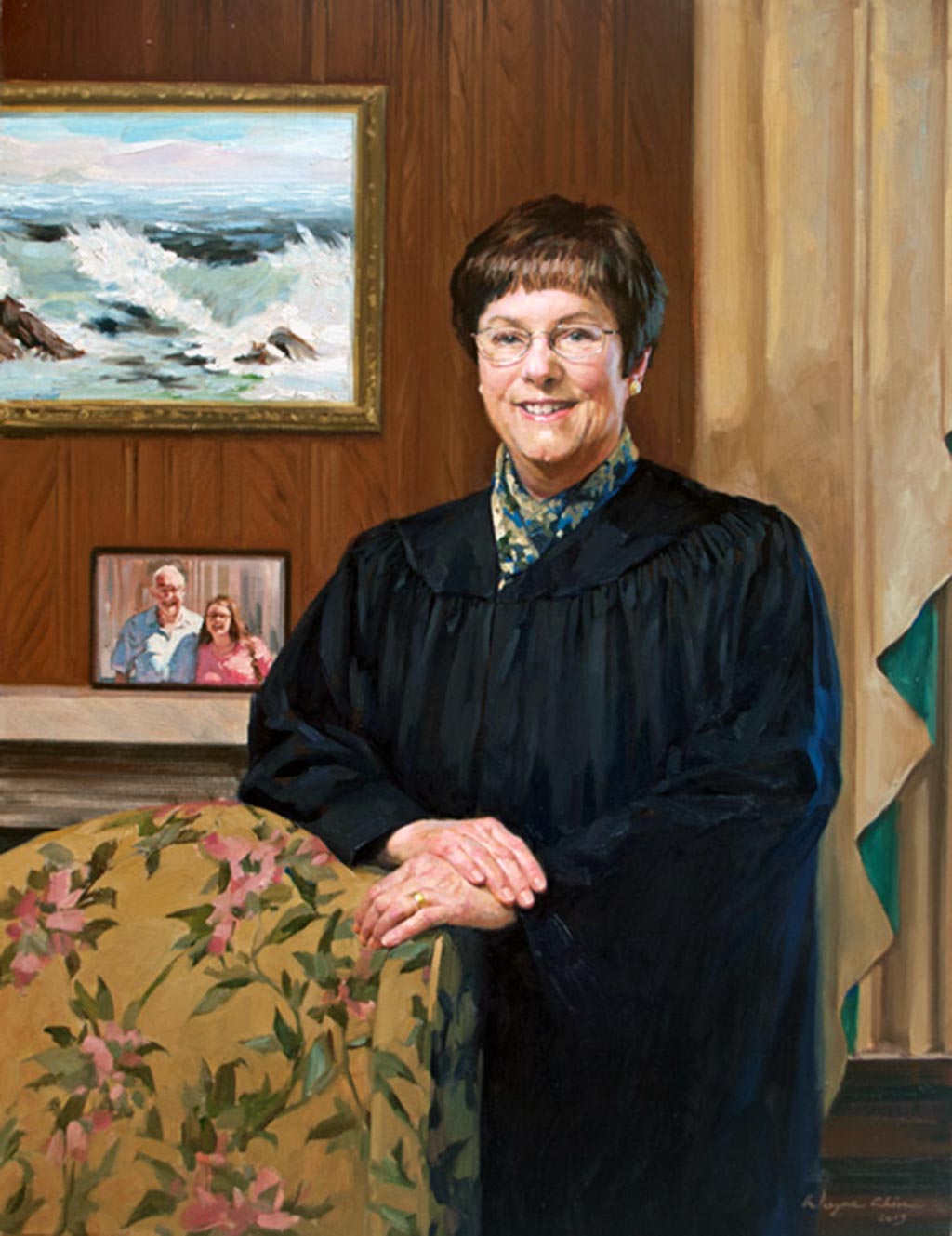a timeline of the
UNITED STATES
COURT OF APPEALS
NINTH CIRCUIT
The United States Courts are often called the guardians of the Constitution because their rulings protect rights and liberties guaranteed by the nation’s supreme law. The Founders considered an independent federal judiciary essential to ensure fairness and equal justice for all American citizens. The courts do not make laws but, through fair and impartial judgments, determine facts and interpret the law to resolve legal differences and disputes.
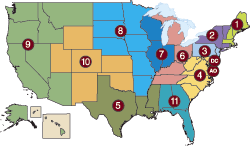 The nation’s 94 judicial districts are organized into 12 regional circuits, each of which has a court of appeals. The United States Court of Appeals for the Ninth Circuit hears appeals from the district courts located within the vast Ninth Circuit as well as appeals from certain federal administrative agencies. The court reviews the decisions and records of proceedings from the district courts. The Ninth Circuit Court of Appeals is one step below the United States Supreme Court. The Ninth Circuit’s history reflects the history of America’s development as a nation and its westward movement.
The nation’s 94 judicial districts are organized into 12 regional circuits, each of which has a court of appeals. The United States Court of Appeals for the Ninth Circuit hears appeals from the district courts located within the vast Ninth Circuit as well as appeals from certain federal administrative agencies. The court reviews the decisions and records of proceedings from the district courts. The Ninth Circuit Court of Appeals is one step below the United States Supreme Court. The Ninth Circuit’s history reflects the history of America’s development as a nation and its westward movement.
1787
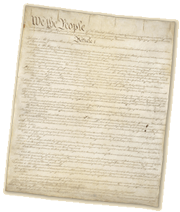 UNITED STATES CONSTITUTION
UNITED STATES CONSTITUTION
The United States Constitution is ratified by enough states to become the “law of the land.” Article Three establishes the third, the judicial, branch of the new government.
Preamble
We the People of the United States, in Order to form a more perfect Union, establish Justice, insure domestic Tranquility, provide for the common defence, promote the general Welfare, and secure the Blessings of Liberty to ourselves and our Posterity, do ordain and establish this Constitution for the United States of America.
Article Three
Section 1
The judicial Power of the United States, shall be vested in one supreme Court, and in such inferior Courts as the Congress may from time to time ordain and establish. The Judges, both of the supreme and inferior Courts, shall hold their Offices during good Behavior, and shall, at stated Times, receive for their Services a Compensation which shall not be diminished during their Continuance in Office.
Section 2
The judicial Power shall extend to all Cases, in Law and Equity, arising under this Constitution, the Laws of the United States, and Treaties made, or which shall be made, under their Authority; to all Cases affecting Ambassadors, other public Ministers and Consuls; to all Cases of admiralty and maritime Jurisdiction; to Controversies to which the United States shall be a Party; to Controversies between two or more States; between a State and Citizens of another State; between Citizens of different States; between Citizens of the same State claiming Lands under Grants of different States, and between a State, or the Citizens thereof, and foreign States, Citizens or Subjects.
In all Cases affecting Ambassadors, other public Ministers and Consuls, and those in which a State shall be Party, the supreme Court shall have original Jurisdiction. In all the other Cases before mentioned, the supreme Court shall have appellate Jurisdiction, both as to Law and Fact, with such Exceptions, and under such Regulations as the Congress shall make.
The Trial of all Crimes, except in Cases of Impeachment, shall be by Jury; and such Trial shall be held in the State where the said Crimes shall have been committed; but when not committed within any State, the Trial shall be at such Place or Places as the Congress may by Law have directed.
See more information on the Documents of American History page.
1789
JUDICIARY ACT OF 1789
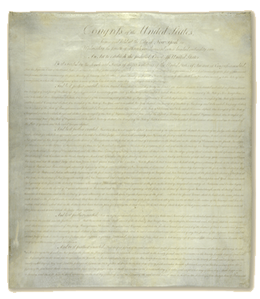
The generality of Article III of the Constitution raises questions that the first Congress addresses in 1789. Congress decides that it can regulate the jurisdiction of all federal courts and, in the Judiciary Act of 1789, establishes a limited jurisdiction for the district and circuit courts, gives the Supreme Court the original jurisdiction provided for in the Constitution, and grants the Court appellate jurisdiction in cases from the federal circuit courts and from the state courts where those courts rulings had rejected federal claims. Although opinions about what constitutes the proper balance of federal and state concerns vary no less today than they did two centuries ago, the fact that today’s federal court system closely resembles the one created in 1789 suggests that the First Congress performed its job admirably. National Archives
See more information on the Documents of American History page.
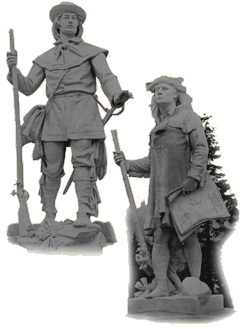 1805
1805
UNITED STATES CORPS OF DISCOVERY
Led by Army Captains Meriwether Lewis and William Clark, the United States Corps of Discovery enters the Oregon Country along the Columbia River. The expedition seeks to learn about the American West—its peoples, landscape, and resources —and to explore possible routes of trade between the East Coast and the Orient. Further, the Corps attempts to legitimize American claims to the land that now makes up the Ninth Circuit. The journals kept by the men document much of what they saw on their two-and-a-half-year journey and become one of the nation’s literary treasures and a comprehensive description of early 19th-century Oregon. Statue of Captain William Clark by Frederick Ruckstuhl OrHi 104304 Statue of Captain Meriwether Lewis by Charles Lopez OrHi 104303
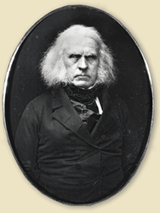 1824
1824
HUDSON’S BAY COMPANY
By the 1820s it’s not the Americans, but the British who control the Oregon Country. In particular, the great international mercantile enterprise Hudson’s Bay Company dominates everything from taking in furs and other products of the land to meting out justice. The company’s local Chief Factor Dr. John McLoughlin rules the vast region with an iron hand. Legal and judicial actions follow British custom. Dr. John McLoughlin OrHi 248
 1840
1840
JOE MEEK
Joe Meek, settles in Oregon after a career in the Rocky Mountain fur trade. Meek plays a leading role in establishing early American government in the Oregon Country, wresting control from the British. He goes on to serve as a census taker, tax collector, legislator and Oregon’s first federal marshal, helping lay down the foundation for the administration of justice. OrHi 10126
Back to top
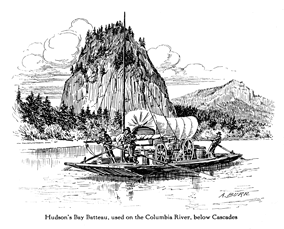 1840s
1840s
OREGON TRAIL
Pioneers from the eastern and midwestern states begin to make their way west over the Oregon Trail, bringing with them their laws and judicial codes. Nearly all of Oregon’s and the Ninth Circuit’s first lawyers and judges arrive via wagon train. Aaron Burr drawing, OrHi 5229
1845
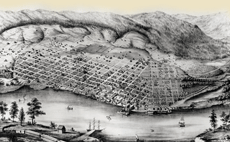 PORTLAND NAMED
PORTLAND NAMED
Boston lawyer Asa Lovejoy and Portland, Maine, merchant Francis Pettygrove plat a town site on the Willamette River, 10 miles upstream from its confluence with the Columbia. In 1845, with the toss of a penny, they give the name Portland rather than Boston to their new town. OrHi 49537
1848
TERRITORY OF OREGON
On August 14, 1848, President James Polk signs legislation creating the Territory of Oregon and appoints three judges to the territorial court. Only Chief Justice William Bryant accepts the appointment, and in April of the following year the territorial court—Oregon’s first federally mandated tribunal—replaces the provisional government’s court. The territorial judges, however, often fail to hold court, impeding the court’s work and spurring a group of Portland lawyers to send a letter of complaint to the president.
Back to top
1853
HOLMES v. FORD
The Territorial Supreme Court of Oregon decides Holmes v. Ford, Oregon City Statesman. Chief Justice George Williams declares that slavery cannot exist in the territory absent some affirmative legislative act establishing it.
1859
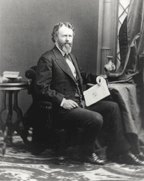 OREGON STATEHOOD
OREGON STATEHOOD
Judge Deady Appointed
Oregon achieves statehood on February 14, 1859, and President James Buchanan appoints Matthew Paul Deady as United States District Judge.Author of the Oregon constitution—the new state’s early statutes and codes—and a member of the first state supreme court, Judge Deady dominates the Oregon legal landscape from the 1850s until his death in 1893. Judicial colleagues from United States Supreme Court justices to state judges praise his learning and ability. A prolific diarist, founder of the Multnomah Public Library, and a theater and operagoer, Deady is one of Portland’s most influential and powerful citizens. Judge Matthew Deady OrHi 9506
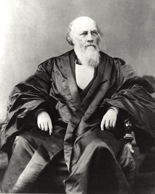 1863
1863
STEPHEN FIELD
Stephen Field, Chief Justice of the California Supreme Court, is appointed to the United States Supreme Court. Field enjoys a long tenure on the Court serving as the circuit justice for the Ninth Circuit and maintains a close friendship with District Judge Matthew P. Deady, with whom he shares a judicial philosophy.
1866
 PIONEER COURTHOUSE DESIGN
PIONEER COURTHOUSE DESIGN
Supervising Architect of the Treasury Department Alfred Mullett begins work on the architectural concept for the Portland Post Office, Customs, and Courthouse, soon to be named the Pioneer Courthouse. Mullett completes the architectural work in 1868, a year before the federal government purchases the block on which the building will be built.
Back to top
1869
COURTHOUSE CONSTRUCTION
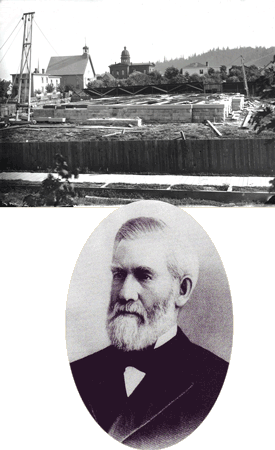 Construction commences on the Pioneer Courthouse as the Pacific Northwest’s principal federal office building. Immediately complaints begin about its distance from the downtown, which lies several blocks to the east and north. Portlanders, however, soon begin to take pride in the stately Italianate structure rising in what will before long become the heart of the city. OrHi 26514
Construction commences on the Pioneer Courthouse as the Pacific Northwest’s principal federal office building. Immediately complaints begin about its distance from the downtown, which lies several blocks to the east and north. Portlanders, however, soon begin to take pride in the stately Italianate structure rising in what will before long become the heart of the city. OrHi 26514
1870
LORENZO SAWYER
Lorenzo Sawyer is appointed circuit judge for the Ninth Circuit.
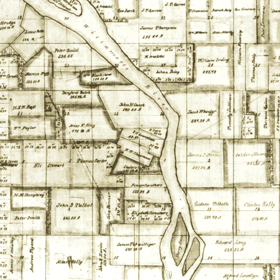 1873 & 1875
1873 & 1875
LAND DISPUTE CASES LAMB v. DAVENPORT and STARK v. STARR
Lamb v. Davenport, 85 U.S. 307, and Stark v. Starr, 94 U.S. 477, two Deady-era land-dispute cases, are decided by the Supreme Court and help settle hundreds of Donation Act land claims in and around Portland. OrHi 25718
1875
BUILDING COMPLETED
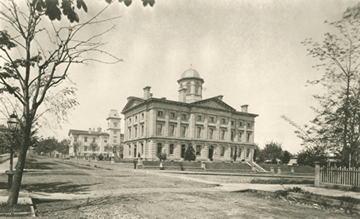 The Pioneer Courthouse is completed at a cost of $611,165. United States District Court Judge Matthew P. Deady moves into his spacious chambers and commences trials in the formal second-floor courtroom. With Supreme Court Justice Stephen Field and Circuit Judge Lorenzo Sawyer, Deady occasionally sits as a circuit judge, hearing appeals from district courts on the West Coast. OrHi 26593
The Pioneer Courthouse is completed at a cost of $611,165. United States District Court Judge Matthew P. Deady moves into his spacious chambers and commences trials in the formal second-floor courtroom. With Supreme Court Justice Stephen Field and Circuit Judge Lorenzo Sawyer, Deady occasionally sits as a circuit judge, hearing appeals from district courts on the West Coast. OrHi 26593
Back to top
1877
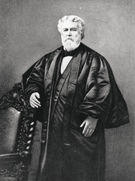 PENNOYER v. NEFF
PENNOYER v. NEFF
United States Supreme Court decides Pennoyer v. Neff, 95 U.S. 714. Originating in District Judge Matthew P. Deady’s court, the case originates from a dispute over the ownership and distribution of land belonging to a man (Neff) who was out-of-state and not personally notified of a case pending against him. The Supreme Court holds that the court in Oregon did not have sufficient jurisdiction over Neff, because he was not physically present here. The case establishes early and important limitations on personal jurisdiction. It remains, arguably, the most famous case to come out of Oregon. Presiding
Judge Matthew Deady OrHi 77105
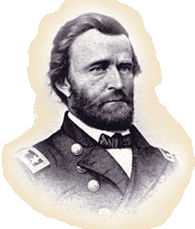 1879
1879
PRESIDENT ULYSSES S. GRANT
Former President Ulysses S. Grant, only one year out of office, visits Portland and, after touring the Pioneer Courthouse, addresses the assembled citizens and children of the city from the Sixth Avenue side of the building. OrHi 24676
1880
PRESIDENT RUTHERFORD B. HAYES
President Rutherford B. Hayes visits the Pioneer Courthouse and climbs the stairs to the cupola to view what was described as “the magnificent view of the city, the river, and the mountains beyond.”
Back to top
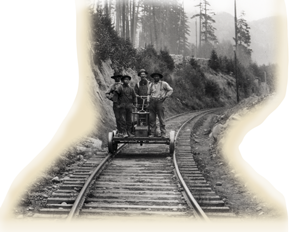 1883
1883
THE RAILROAD
Railroad surveys in Oregon begin in the 1850s, but only in 1883 is Portland connected to the transcontinental rail system. Federal court dockets throughout the West become filled with cases involving railroad companies and their lands, rates, disputes among themselves and with customers, states, and the federal government itself. OrHi 50082
1891
PRESIDENT BENJAMIN HARRISON
President Benjamin Harrison, on a visit to Portland, views a parade in his honor from the grounds of the Pioneer Courthouse. With him is the United States Postmaster General John Wanamaker, who inspects the post office quarters within the building and notes that more space is needed, initiating the 10-year effort to enlarge the Pioneer Courthouse.
JUDICIARY ACT OF 1891
Congress passes the Judiciary Act of 1891, also known as the Evarts Act after its author Senator William Evarts, which creates the United States Courts of Appeals. Appeals from the federal district courts are now reassigned from the old circuit courts to these new appellate courts, except for certain cases that can be appealed directly to the Supreme Court.
UNITED STATES COURT OF APPEALS FOR THE NINTH CIRCUIT
The United States Court of Appeals for the Ninth Circuit, newly created by the Evarts Act, holds its inaugural session on June 16, 1891, in the Appraisers’ Building in San Francisco. Supreme Court Justice Stephen Field presides with Circuit Judge Lorenzo Sawyer in attendance. To complete the requisite three-judge panel, Justice Field announces that Oregon District Court Judge Matthew P. Deady will sit on the appellate bench by designation.
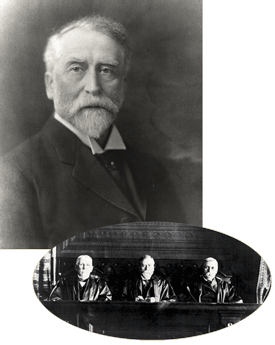 1892
1892
WILLIAM BALL GILBERT
President Benjamin Harrison appoints Oregonian William Ball Gilbert to the newly created Ninth Circuit Court of Appeals, the first Oregon judge to serve on this court. Born and raised in Virginia, William Ball Gilbert is a descendant of the illustrious Colonel William Ball, who emigrated from England in 1650 and was the grandfather of George Washington’s mother, Mary Ball. Judge Gilbert is the ranking judge in the Ninth Circuit for nearly 35 years and his opinions span almost 300 volumes of the Federal Reporter. Judge Gilbert’s opinions on many cases during his decades on the court contribute significantly to the development of Ninth Circuit law. Left to right, Judges Morrow, Gilbert, and Ross
 1900
1900
MINERAL RESOURCES
The prospect for gold, silver, and other mineral resources lures thousands of miners to Oregon and other states in the growing Ninth Circuit. Disputes over mining claims, cases involving accidents and injuries, and efforts to recoup losses from damage to land and water fill the Circuit’s trial and appellate courts’ dockets. OrHi 13222
Back to top
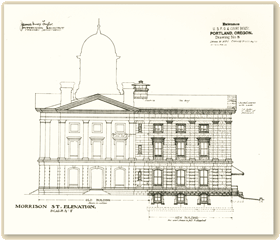 1902
1902
EXTENSION OF PIONEER COURTHOUSE
Congress approves funds for an extension of Pioneer Courthouse, and the Treasury Department authorizes construction of two new wings on the west facade to accommodate the post office’s need for additional space. Completed by 1905, these additions are built of the same type of stone (sandstone), though from a different quarry. OrHi 26583
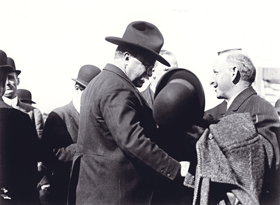 1903
1903
PRESIDENT THEODORE ROOSEVELT
President Theodore Roosevelt visits Portland to help launch the effort to hold a world’s fair in Portland in 1905. The president stays at the Portland Hotel, across Sixth Avenue from the courthouse, and gives a speech with the audience spreading across the street to the grounds of the Pioneer Courthouse. OrHi 105549
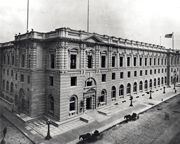 1905
1905
NINTH CIRCUIT’S OWN FIRST BUILDING
The Ninth Circuit’s own first building, shared with the post office, opens at Seventh and Mission Streets in San Francisco and is immediately considered one of the finest architectural structures in the West. Sustaining only light damage from the 1906 earthquake and fire, it becomes a central message place for survivors and visitors.
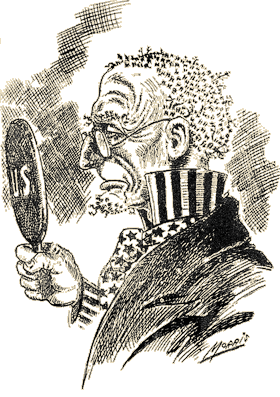 1906
1906
TIMBER AND LAND FRAUD
The scramble for resources—timber, mineral, grazing land—in the late 19th and early 20th centuries puts public and private interests on a collision course. Numerous trials for timber and land fraud are held in the Pioneer Courthouse and other courthouses throughout the Ninth Circuit. By 1906 and, in part, because of the rampant fraud being perpetrated on public lands, President Theodore Roosevelt creates 10 new forest reserves and moves the conservation ethic onto the American agenda.
Back to top
1910
PRESIDENT WILLIAM HOWARD TAFT
President William Howard Taft visits Portland and stops at the Pioneer Courthouse on his parade up Morrison Street.
1912
BUILDINGS RISE AROUND
PIONEER COURTHOUSE
 In the 20 years between 1892 and 1912, a collection of larger, yet architecturally distinct, buildings rise around Pioneer Courthouse. The courthouse now sits in a canyon of terra cotta buildings that, while manifesting the popular City Beautiful movement of this time, hide the once-prominent landmark and cut it off from its famed views of the river, mountains, and the surrounding cityscape. OrHi 4906
In the 20 years between 1892 and 1912, a collection of larger, yet architecturally distinct, buildings rise around Pioneer Courthouse. The courthouse now sits in a canyon of terra cotta buildings that, while manifesting the popular City Beautiful movement of this time, hide the once-prominent landmark and cut it off from its famed views of the river, mountains, and the surrounding cityscape. OrHi 4906
1923
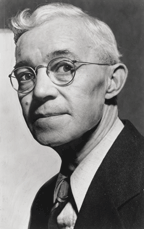 PIERCE v. SOCIETY OF SISTERS
PIERCE v. SOCIETY OF SISTERS
Through initiative and legislation following a campaign spearheaded by Ku Klux Klan leader Fred Louis Gifford, Oregonians in 1922 pass the "Compulsory School Bill," an anti-Catholic effort toward abolishing parochial schools. The Society of Sisters orphanage challenges the school bill in federal court. The Ninth Circuit finds that Oregon students have a constitutional right to attend parochial schools protected by the Fourteenth Amendment. In Pierce v. Society of Sisters, 268 U.S. 510 (1925), the Supreme Court affirms the Ninth Circuit’s decision, marking a turning point in defining the "Liberty Clause" of the Fourteenth Amendment. Nearly 50 years later, the Court, citing Pierce, upholds the right of Amish parents to withdraw their children from public school after the eighth grade. Fred Louis Gifford OrHi 87769, OrHi 17470
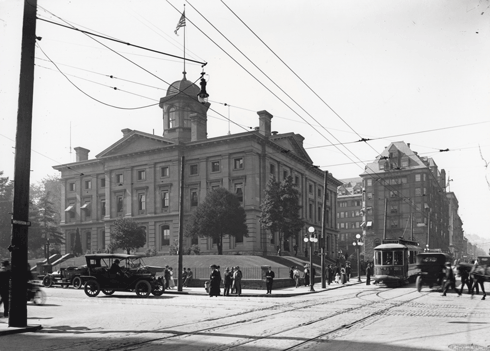
Back to top
1925
WALLACE McCAMANT
Wallace McCamant, a former associate justice on the Oregon Supreme Court, is appointed to the Ninth Circuit Court of Appeals by President Calvin Coolidge during the Senate’s recess. His appointment is temporary, pending Senate confirmation. Upon returning from its recess, the Senate rejects McCamant’s nomination, ending his brief judicial career as the only circuit judge in the country’s history to suffer rejection by the Senate after serving under a recess appointment.
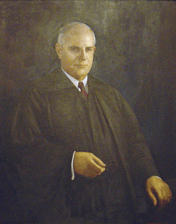 1935
1935
BERT E. HANEY
Oregon attorney and member of the United States Shipping Board Bert E. Haney is appointed to the Court of Appeals by President Franklin D. Roosevelt.
1937
DeJONG v. OREGON
The United States Supreme Court hands down a decision in DeJonge v. Oregon, 299 U.S. 353, holding that Dirk DeJonge, who spoke at a public meeting called by the Communist Party, could not be prosecuted for speaking at an event where no laws had been broken and no one was incited to break the law. DeJonge is represented by attorney Gus J. Solomon, who is later (1949) appointed United States district judge by President Harry S. Truman.
1939
COURTHOUSE DEMOLITION AUTHORIZED
A bill authorizing the demolition of Pioneer Courthouse passes both houses of Congress and is signed by the president. With the Great Depression still lingering and the nation beginning to support the Allied war effort in Europe, funds for the work are never appropriated. Pioneer Courthouse remains standing.
Back to top
 1942
1942
COURTHOUSE REACTIVATED
With America’s entry into World War II and the government’s need for space to house an expanding military workforce, Pioneer Courthouse is reactivated. The building becomes Portland’s "Victory Center," where morale-boosting shows take place and the government sells war bonds. OrHi 123456
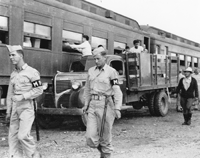 1943
1943
JAPANESE AMERICAN EXCLUSION CASES
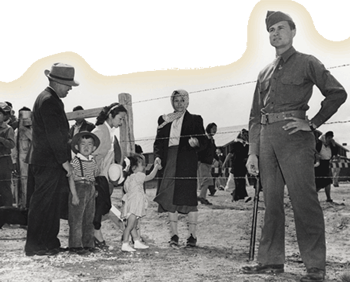 The treatment of Japanese Americans during World War II is one of the darker chapters in the nation’s 20th-century history, for it is during the war that the Japanese exclusion cases arise. The federal government requires that Japanese Americans observe special curfews and report to "relocation centers," internment camps located throughout the western states. These requirements lead to several court challenges, which the Ninth Circuit sends directly to the Supreme Court. In such cases as Yasui v. United States 320 U.S. 115, and Hirabayashi v. United States, 320 U.S. 81, 85, the Court rules that the federal government may impose restrictions on Japanese-American citizens. Strong feelings about the exclusion orders continue long after the war: the nation eventually apologizes and Portland dedicates a riverfront garden memorializing this painful episode. OrHi 44613,
OrHi 44601
The treatment of Japanese Americans during World War II is one of the darker chapters in the nation’s 20th-century history, for it is during the war that the Japanese exclusion cases arise. The federal government requires that Japanese Americans observe special curfews and report to "relocation centers," internment camps located throughout the western states. These requirements lead to several court challenges, which the Ninth Circuit sends directly to the Supreme Court. In such cases as Yasui v. United States 320 U.S. 115, and Hirabayashi v. United States, 320 U.S. 81, 85, the Court rules that the federal government may impose restrictions on Japanese-American citizens. Strong feelings about the exclusion orders continue long after the war: the nation eventually apologizes and Portland dedicates a riverfront garden memorializing this painful episode. OrHi 44613,
OrHi 44601
1945
WATER CONTROL
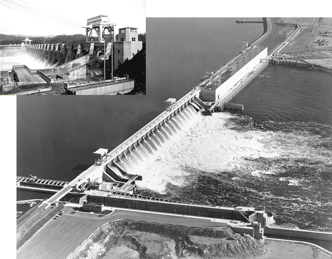 Although the impetus for water control begins with the enactment of the Reclamation Act of 1902, before the New Deal only a few projects are launched in the Ninth Circuit. The great water projects of the 1930s and 1940s—Bonneville Dam, Grand Coulee Dam, the Central Valley Project—change the American West. The complexity of these undertakings—involving rivers, dams, electricity, irrigation, Indian fishing rights and fisheries management, and flood control—leads to legal disputes that require western federal courts’ attention. The Supreme Court’s ability to review only a small number of cases leaves the Ninth Circuit effectively as the court of last resort in the many water-related cases that are filed. OrHi 14804 and OrHi 2609, right
Although the impetus for water control begins with the enactment of the Reclamation Act of 1902, before the New Deal only a few projects are launched in the Ninth Circuit. The great water projects of the 1930s and 1940s—Bonneville Dam, Grand Coulee Dam, the Central Valley Project—change the American West. The complexity of these undertakings—involving rivers, dams, electricity, irrigation, Indian fishing rights and fisheries management, and flood control—leads to legal disputes that require western federal courts’ attention. The Supreme Court’s ability to review only a small number of cases leaves the Ninth Circuit effectively as the court of last resort in the many water-related cases that are filed. OrHi 14804 and OrHi 2609, right
Back to top
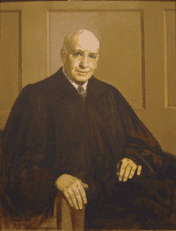 1954
1954
JAMES ALGER FEE
Following a distinguished, 23-year career as a United States District Judge in Oregon, James Alger Fee is appointed to the Ninth Circuit Court of Appeals in 1954 by President Dwight Eisenhower.
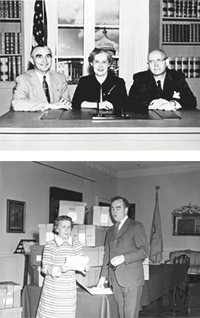 1956
1956
PIONEER COURTHOUSE SEEKS NATIONAL HISTORIC MONUMENT STATUS
At the request of the Portland City Council, Oregon Congresswoman Edith Green, working with Oregon Senators Wayne Morse and Richard Neuberger, introduces federal legislation seeking Pioneer Courthouse’s preservation as a national monument. Congresswoman Green and Oregon Historical Society Director Thomas Vaughan advocate for the building’s preservation. Private efforts by local businesses to demolish the courthouse to build a parking lot are resisted and, by the end of the year, the Courthouse is registered as a National Top Photo: Historic Landmark Morse, Green, and Neuberger OrHi37447 Bottom Photo: Green and Vaughn OrHi 35545
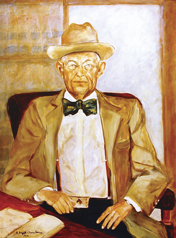 1968
1968
CHIEF JUDGE RICHARD CHAMBERS
Ninth Circuit Chief Judge Richard Chambers persuades the court to move its Oregon headquarters into the Pioneer Courthouse, if the building is restored. Congresswoman Edith Green secures an appropriation for the work, which begins in 1971. Oregon Senator Mark O. Hatfield, who will soon make Pioneer Courthouse the place for his in-state office, adds his own efforts to preserving the building.
 1969
1969
JOHN E. KILKENNY
With an appointment by President Richard Nixon, Oregon District Court Judge John F. Kilkenny is promoted to the Ninth Circuit Court of Appeals. Judge Kilkenny applies his love of Oregon’s landscape and deep interest in historic preservation toward restoring Pioneer Courthouse and maintains his residence in Portland rather than in the Circuit’s headquarters of San Francisco.
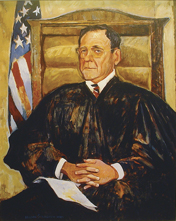 1971
1971
ALFRED T. GOODWIN
President Nixon promotes Oregon District Court Judge and former Oregon Supreme Court Justice Alfred T. Goodwin to the Court of Appeals. Sharing a strong sense of Oregon history with his colleague Judge Kilkenny, Judge Goodwin adds his own energies to Pioneer Courthouse’s restoration.
Back to top
1973
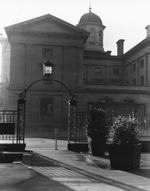
RESTORATION OF PIONEER COURTHOUSE
Portland architect George McMath, of Allen, McMath, Hawkins and Associates, oversees the restoration of Pioneer Courthouse. The building is rededicated on May 1, 1973, and houses the United States Court of Appeals for the Ninth Circuit and the federal bankruptcy court. The restoration includes repairs to the exterior walls, using epoxy mixed with ground stone from the original quarry to replicate the original stonework. The chimneys are stabilized and all surfaces are sealed and waterproofed. The interior of the building also is fully rehabilitated with fixtures matching the original 1875 structure and installation of new air conditioning, ventilation, and partial sprinkler systems. Judges Chambers and Kilkenny gather furniture from across the country to furnish the courtroom and other public spaces: bench lamps from Chicago; public benches from St. Paul, Minnesota; counsel tables from Butte, Montana. Oregonians donate additional historical articles. OrHi 104266 (plan) and 9353
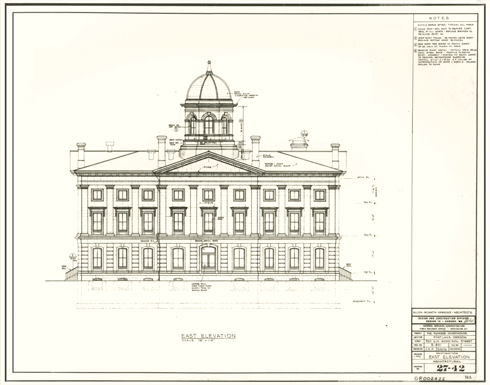
1977
INDIAN FISHING RIGHTS
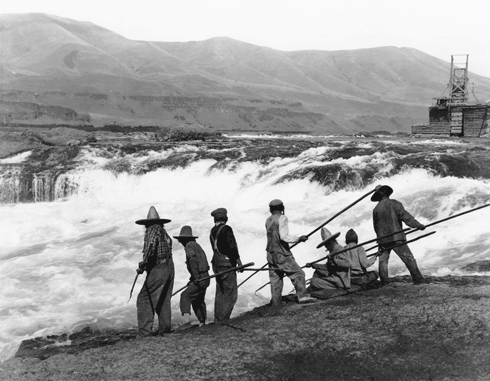 Northwest Indian tribes and the federal government share a long and troubled history relating to Indian fishing rights, a story that continues to be written in the Ninth Circuit. District Judges Robert Belloni (Sohappy v. Smith, 302 F. Supp. 899 [D. Or. 1969]) and George Boldt (United States v. Washington, 384 F. Supp. 312 [W.D. Wash. 1974]) reaffirm the federal government’s guarantee to northwest Indians the right to fish "at all usual and accustomed places." The Ninth Circuit Court of Appeals is asked to balance fishing rights with environmental and other concerns in a series of cases that continues today. OrHi 4463
Northwest Indian tribes and the federal government share a long and troubled history relating to Indian fishing rights, a story that continues to be written in the Ninth Circuit. District Judges Robert Belloni (Sohappy v. Smith, 302 F. Supp. 899 [D. Or. 1969]) and George Boldt (United States v. Washington, 384 F. Supp. 312 [W.D. Wash. 1974]) reaffirm the federal government’s guarantee to northwest Indians the right to fish "at all usual and accustomed places." The Ninth Circuit Court of Appeals is asked to balance fishing rights with environmental and other concerns in a series of cases that continues today. OrHi 4463
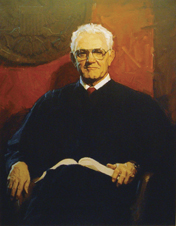 1979
1979
OTTO R. SKOPIL, JR.
President Jimmy Carter promotes Oregon District Court Judge Otto R. Skopil, Jr., to the Court of Appeals. Judge Skopil is recognized for his many contributions to legal education and, particularly, the work of magistrates within the federal judiciary.
Back to top
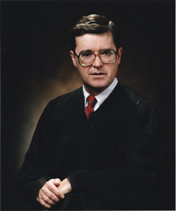 1986
1986
DIARMUID F. O’SCANNLAIN
A former Oregon Public Utility Commissioner and Director of the Oregon Department of Environmental Quality, Diarmuid F. O’Scannlain is appointed to the Court of Appeals by President Ronald Reagan. With concerns growing over Pioneer Courthouse’s ability to withstand earthquakes, Judge O’Scannlain takes the lead to rehabilitate the building and strengthen its seismic infrastructure, an effort that is rewarded with the building’s upgrade and rehabilitation in 2005.
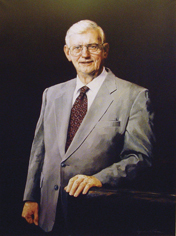 1987
1987
EDWARD LEAVY
President Reagan promotes Oregon District Court Judge Edward Leavy to the Court of Appeals. Judge Leavy’s service on the court is a continuation of a long judicial career, beginning with his appointment to the state bench at the age of 27.
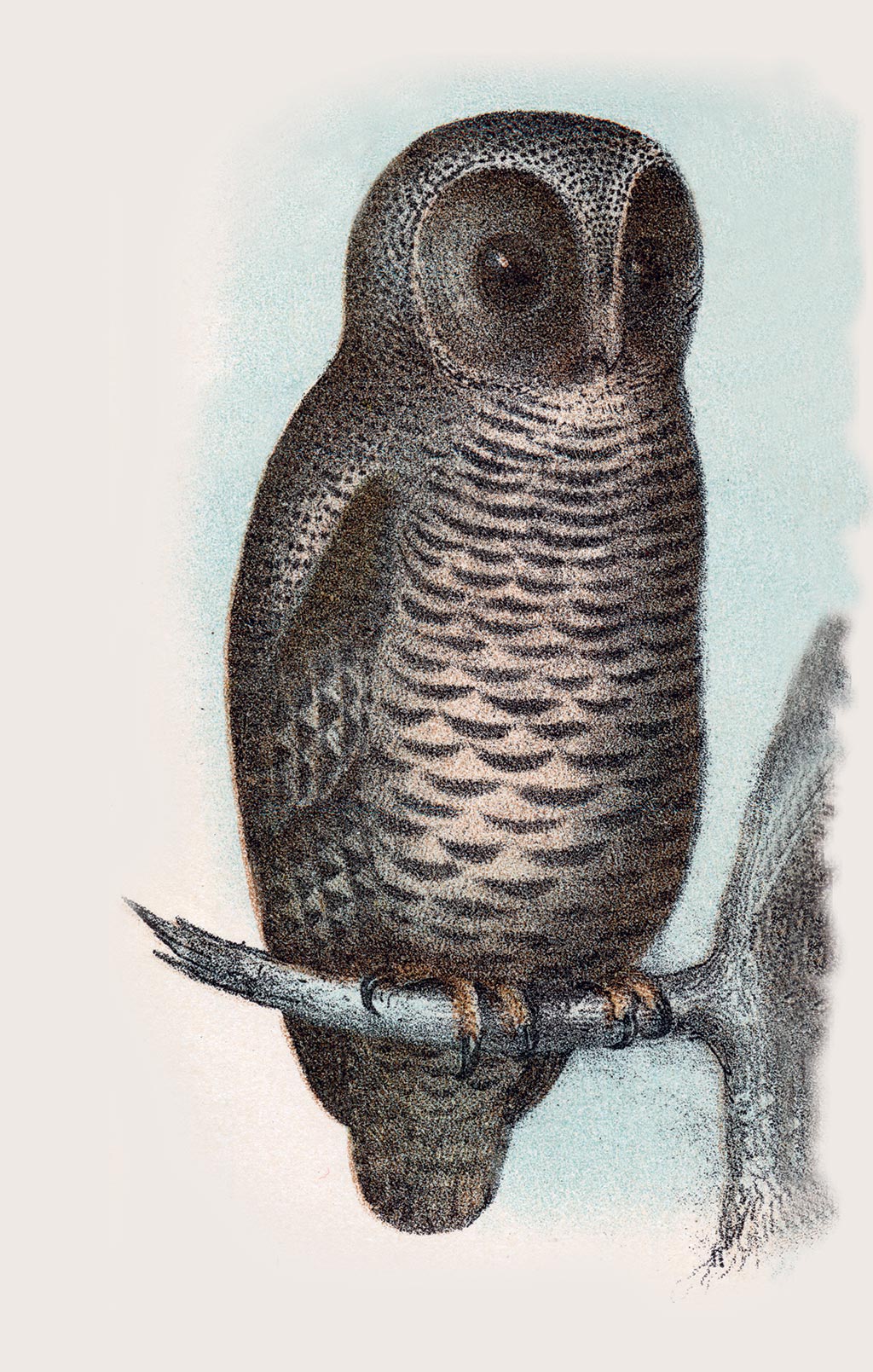 1988
1988
NORTHERN SPOTTED OWL
Beginning in the early 1970s, the northern spotted owl is considered for protection under the Endangered Species Act of 1973. A series of cases shuttles between the federal district courts and the Ninth Circuit Court of Appeals, culminating with Seattle Audubon Society v. Evans. The battle between forest-lands conservationists and the Pacific Northwest timber industry affects the region’s economy, and politics and social life in many communities. Pioneer Courthouse continues to host many legal disputes and debates surrounding timber and the environment. from The Birds of North America, 1888
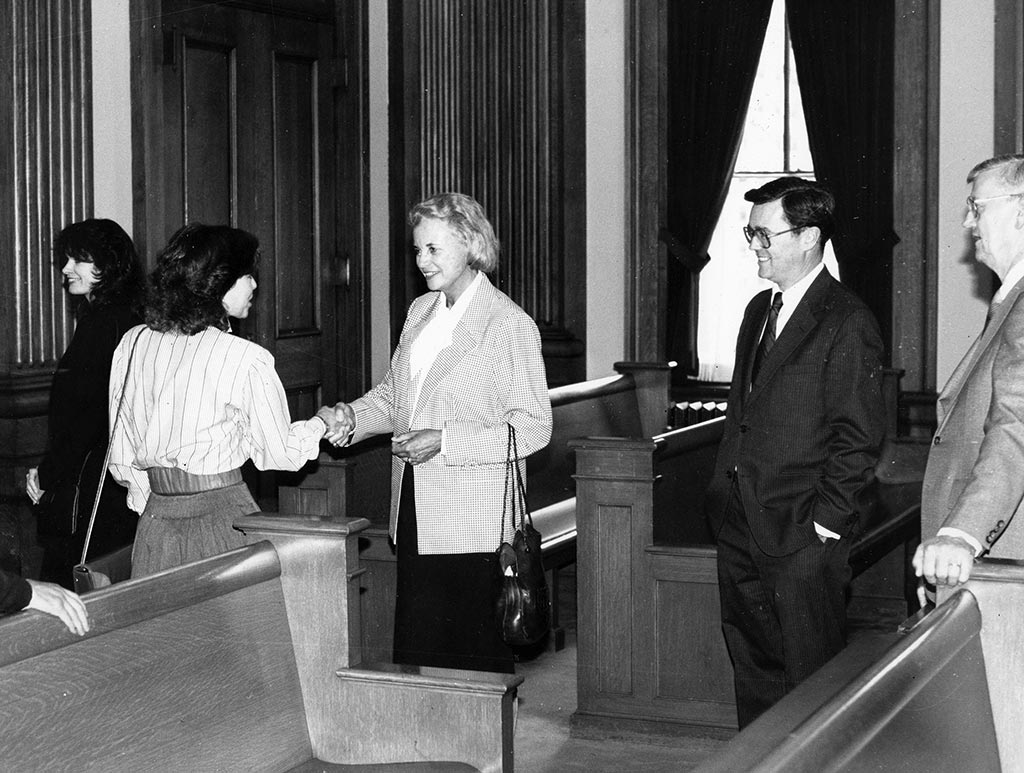 VISIT BY SUPREME COURT ASSOCIATE JUSTICE SANDRA DAY O’CONNOR
VISIT BY SUPREME COURT ASSOCIATE JUSTICE SANDRA DAY O’CONNOR
United States Supreme Court Associate Justice O’Connor visits Pioneer Courthouse as part of her duties as circuit justice. Attended by Ninth Circuit Judges Diarmuid O’Scannlain and Edward Leavy, Justice O’Connor meets with law clerks and other court staff. photo: OrHi 83280-0
Back to top
1996
ASSISTED SUICIDE
In a significant death-with-dignity case, the Ninth Circuit Court of Appeals issues a decision in Compassion in Dying v. Washington. Judge Diarmuid O’Scannlain dissents from the full court’s refusal to rehear the case en banc. The United States Supreme Court unanimously reverses the Circuit, rejecting the plaintiffs’ challenge to the state law banning physician-assisted suicide for reasons stated in Judge O’Scannlain’s dissent. Later, in Oregon v. Ashcroft, the Ninth Circuit Court of Appeals rules that the U.S. Attorney General cannot enforce the federal Controlled Substances Act against physicians who prescribed drugs, in compliance with Oregon state law, to terminally ill patients seeking to end their lives, often referred to as “assisted suicide.” The Supreme Court upholds the Ninth Circuit’s decision.
1998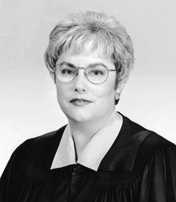
SUSAN GRABER
President Bill Clinton nominates Oregon Supreme Court Justice Susan Graber to the Ninth Circuit Court of Appeals. She is confirmed, unanimously, as the state’s first female judge on the court.
2002
PLEDGE OF ALLEGIANCE
In June, a three-judge panel of the Ninth Circuit Court of Appeals holds 2–1 that the phrase “under God,” inserted into the Pledge of Allegiance in 1954 by an act of Congress, violates the Establishment Clause of the First Amendment to the United States Constitution. Judge Alfred Goodwin writes the majority opinion in Newdow v. U.S. Congress. The decision elicits strong criticism from around the country and across the political spectrum, but the full court rejects a call to rehear the matter en banc. Judge Diarmuid O’Scannlain dissents from the order rejecting en banc rehearing and is joined by five colleagues. The Supreme Court later reverses the Ninth Circuit’s decision on the ground that the plaintiff lacked standing to bring the case; the Court did not decide the constitutionality of the Pledge. photo of children: Alamy AAMTBH
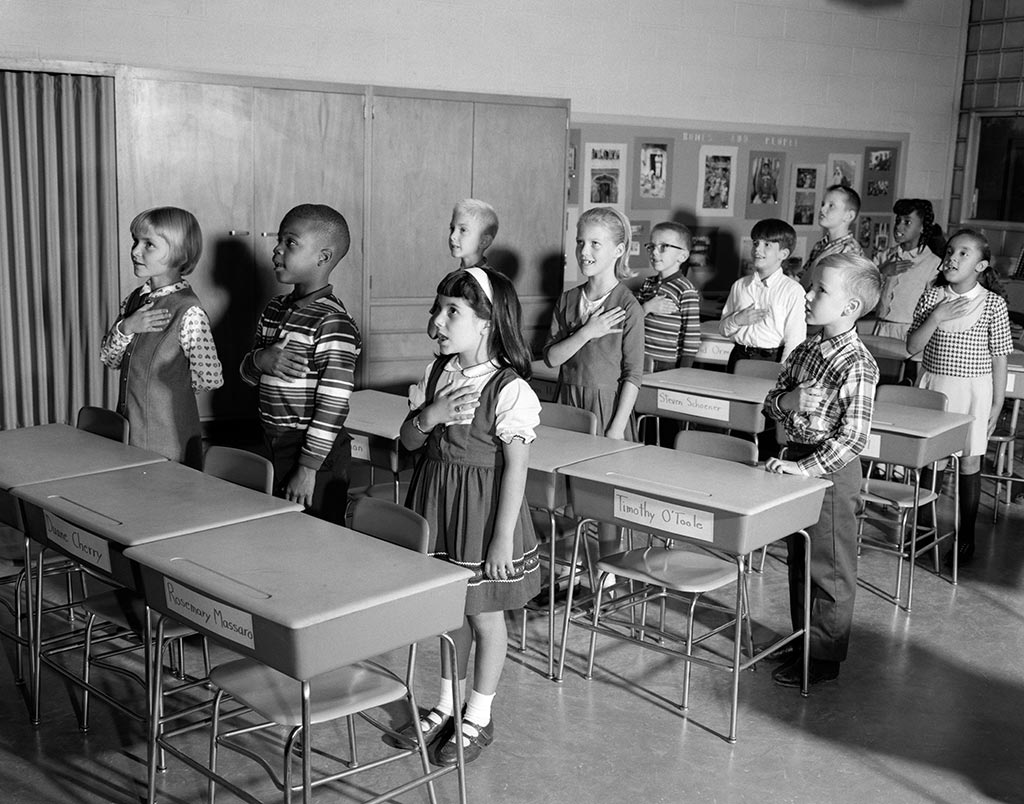
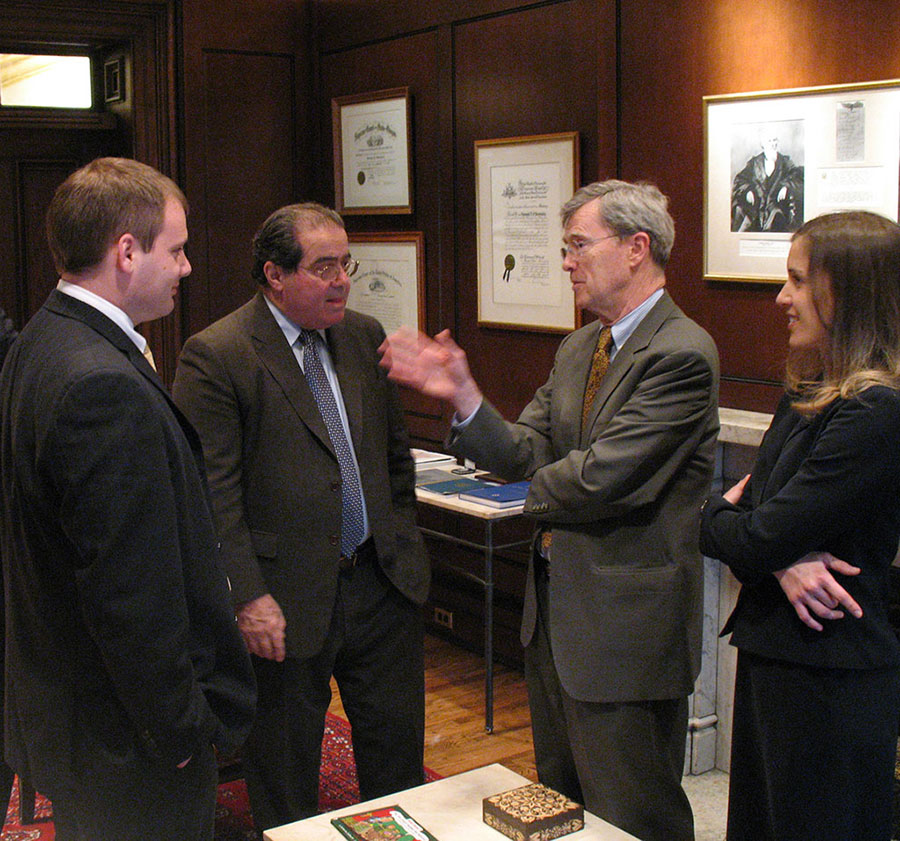
VISIT BY SUPREME COURT ASSOCIATE JUSTICE ANTONIN SCALIA
United States Supreme Court Associate Justice Antonin Scalia visits Pioneer Courthouse and Lewis and Clark Law School, where he dedicates the Louise and Erskine Wood, Sr., Hall. Justice Scalia meets with judges, law clerks, and other court staff.
Back to top
2006
BAN ON PAY-PER-SIGNATURE
In 2002, Oregon Ballot Measure 26 was approved by popular vote. It forbade initiative sponsors from paying petitioners on a per-signature basis. The Ninth Circuit Court of Appeals upholds the ban on pay-per-signature in Prete v. Bradbury.
2008
VISIT BY SUPREME COURT ASSOCIATE JUSTICES SANDRA DAY O’CONNOR AND ANTHONY KENNEDY
Pioneer Courthouse is honored by the visits of United States Supreme Court Associate Justices Sandra Day O’Connor and Anthony Kennedy in September.
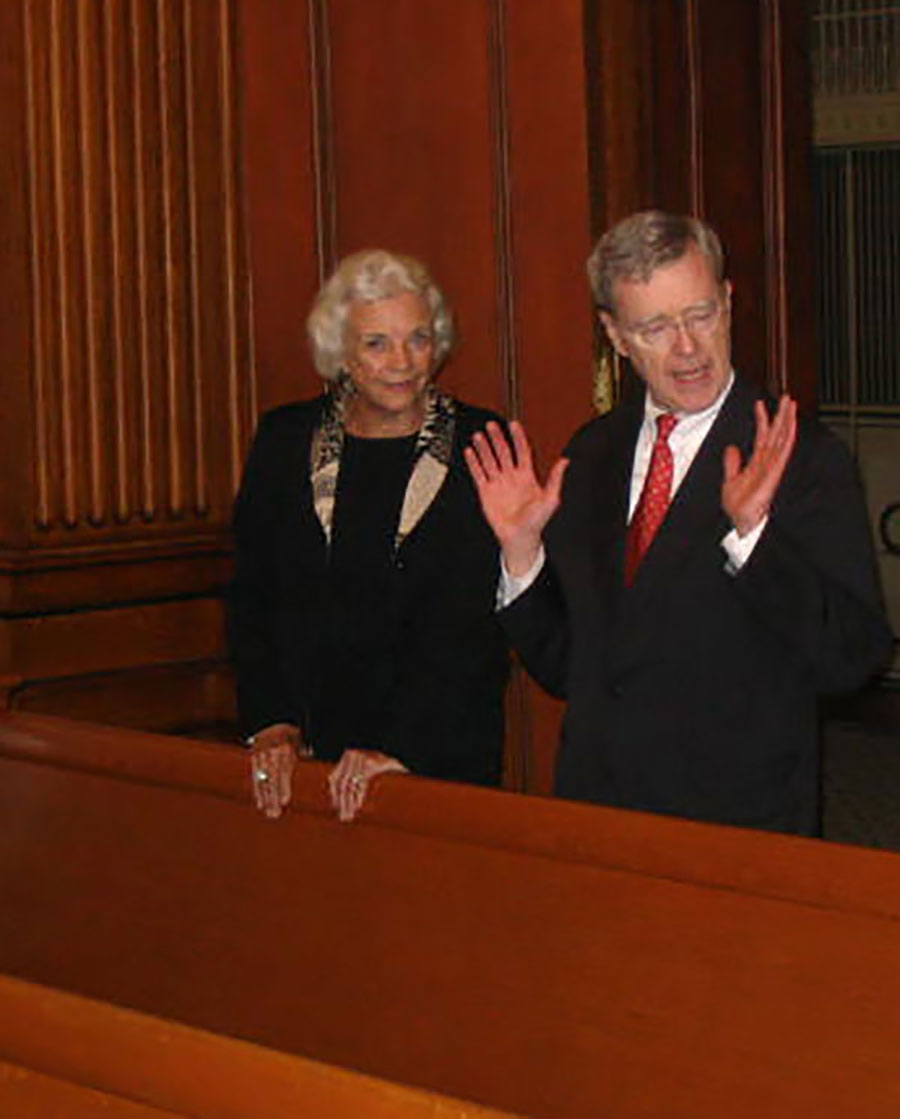
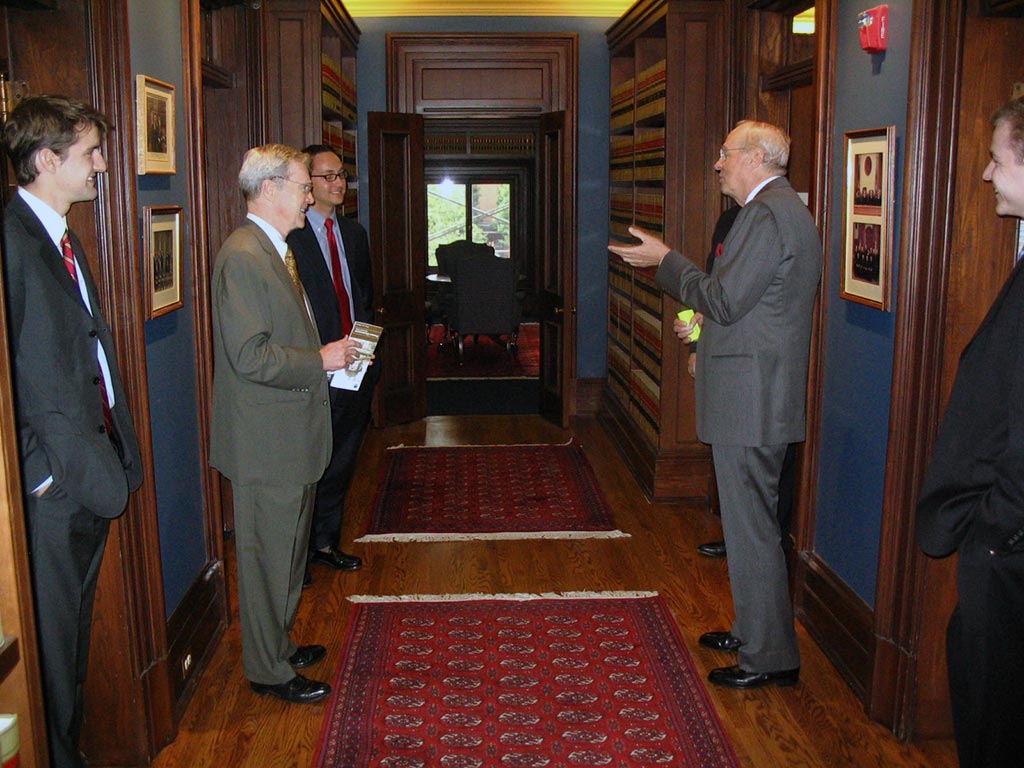
2009
VISIT BY SUPREME COURT ASSOCIATE JUSTICE RUTH BADER GINSBURG
Supreme Court Associate Justice Ruth Bader Ginsburg visits Pioneer Courthouse after speaking at Temple Beth Israel. She is led through the courthouse by Ninth Circuit Judge Susan Graber and is also greeted by Judges Diarmuid O’Scannlain and Edward Leavy.
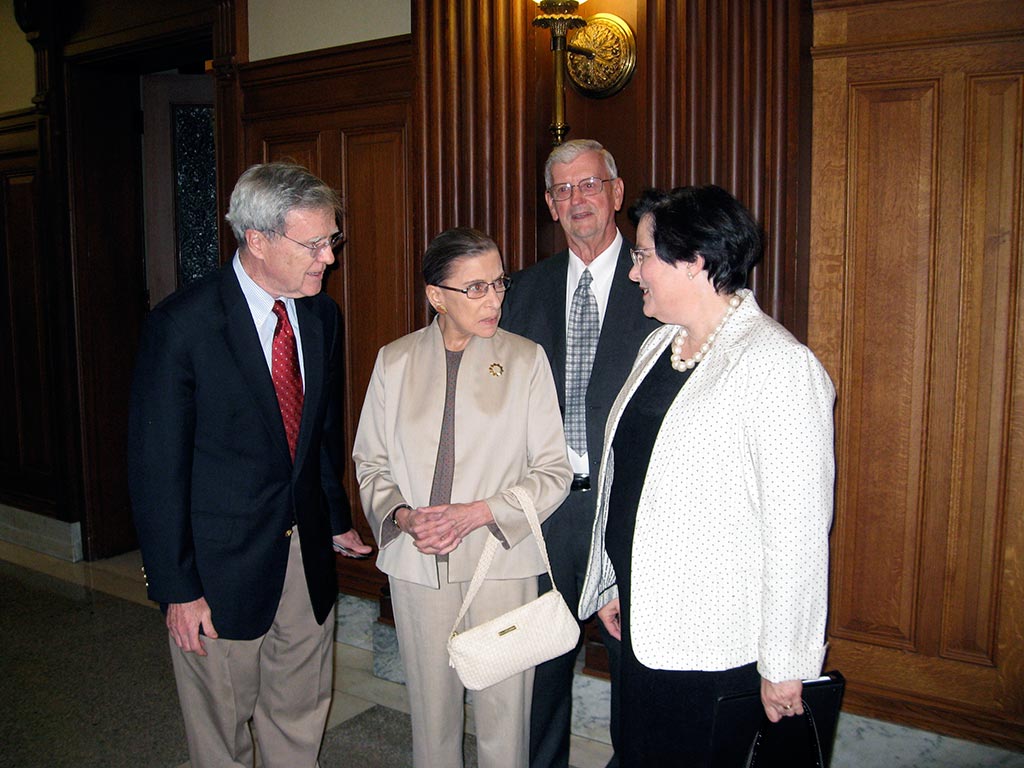
ALLEGATIONS THAT SECRET SERVICE AGENTS VIOLATED THE FIRST AMENDMENT
In Moss v. U.S. Secret Service, the Ninth Circuit Court of Appeals holds that protestors stated a claim that during President George W. Bush’s visit to Jacksonville, Oregon, two Secret Service agents violated the First Amendment by ordering the relocation of protestors critical of the President. Judge Diarmuid O’Scannlain dissents from the denial of rehearing en banc, arguing the Secret Service agents were entitled to qualified immunity. The Supreme Court unanimously reverses the Ninth Circuit’s decision, agreeing with Judge O’Scannlain.
SPECIAL-EDUCATION SERVICES
In Forest Grove School District v. T.A., pertaining to a student in Forest Grove, Oregon, Judge Susan Graber writes for the Ninth Circuit Court of Appeals that students who had not previously received special education services under the Individuals with Disabilities Education Act are nonetheless eligible for tuition reimbursement under that Act. The Supreme Court affirms the decision.
Back to top
2010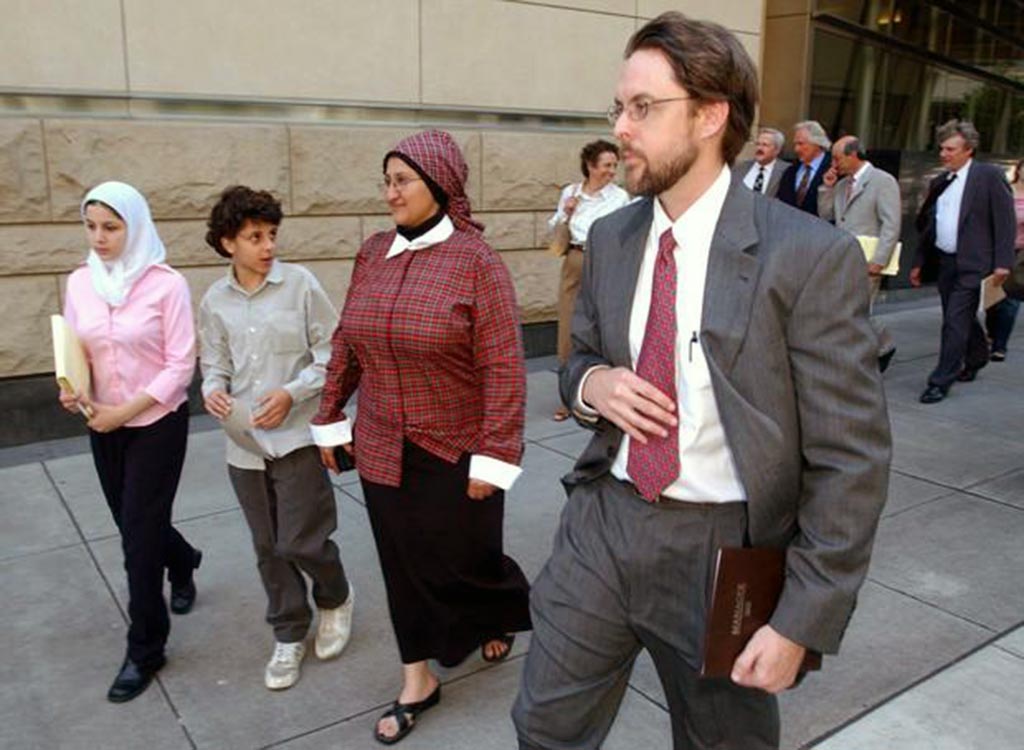
WRONGFUL ACCUSATION
In Mayfield v. United States, the Ninth Circuit Court of Appeals rules that Brandon Mayfield, with whom the government has already settled claims stemming from his having been arrested and wrongly accused of involvement with a Spanish train bombing, lacks standing to seek a ruling that portions of the USA PATRIOT Act are unconstitutional. photo: Jefferson Public Radio
ATTEMPTED BOMBING NEAR PIONEER COURTHOUSE

“Mohamed Osman Mohamud . . . attempt[s] to detonate a large bomb during the annual Christmas Tree Lighting Ceremony in Pioneer Courthouse Square,” as the Ninth Circuit Court of Appeals will later describe the event. The attack does not go as planned—sparing the Pioneer Courthouse and countless lives—because Mohamud’s car bomb is, in fact, an inert replica created by the FBI as part of an elaborate ruse. Mohamud is convicted after a jury trial in 2013 and sentenced to 30 years in prison. The Ninth Circuit affirms his conviction and sentence in 2016, rejecting his claims that the FBI illegally surveilled and entrapped him. Courthouse Square photo from Wikimedia Commons (by Steve Morgan); Mohamud photo from Multnomah County Sheriff’s office.
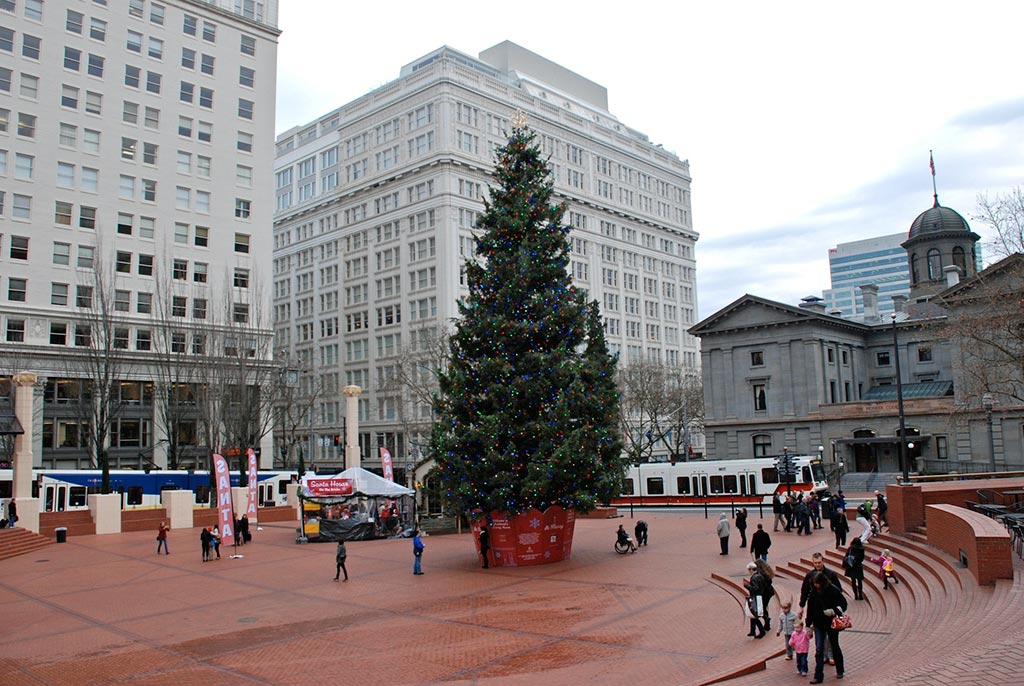
CLEAN WATER ACT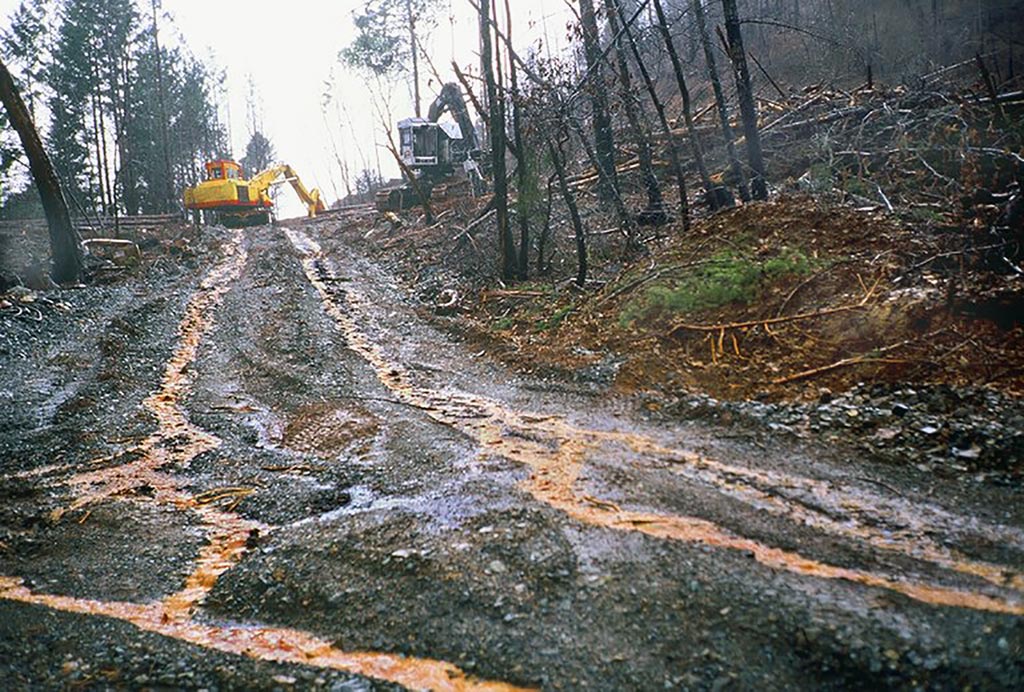
In a unanimous opinion titled Northwest Environmental Defense Center v. Brown, the Ninth Circuit Court of Appeals rules that storm water runoff from logging roads is subject to regulation under the Clean Water Act’s National Pollutant Discharge Elimination System permit program. The Supreme Court subsequently reverses the Ninth Circuit. photo from bark-out.org
2012
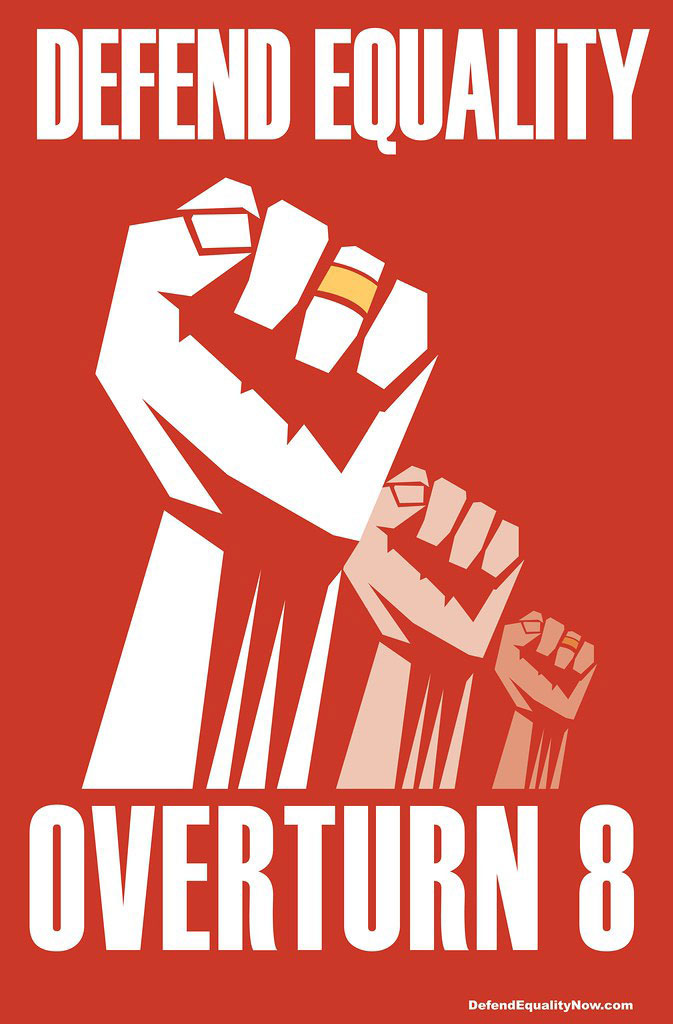
SAME-SEX MARRIAGE
In Perry v. Brown, the Ninth Circuit concludes that California’s Proposition 8 is unconstitutional
on the ground that it “singles out same-sex couples for unequal treatment by taking away from them alone the right to marry.” Judge Diarmuid O’Scannlain dissents from the denial of rehearing en banc. The Supreme Court later agrees with the Ninth Circuit in Obergefell v. Hodges.
Back to top
2013
VISIT BY CHIEF JUSTICE OF THE UNITED STATES JOHN G. ROBERTS, JR.
Chief Justice of the United States John G. Roberts, Jr., honors the Portland legal community by visiting Pioneer Courthouse. Dean Robert Klonoff of the Lewis & Clark Law School and Ninth Circuit Judge Diarmuid O’Scannlain coordinated Chief Justice Roberts’s visit to include his presiding at the inaugural Lewis & Clark Environmental Law Moot Court Advocate of the Year competition.
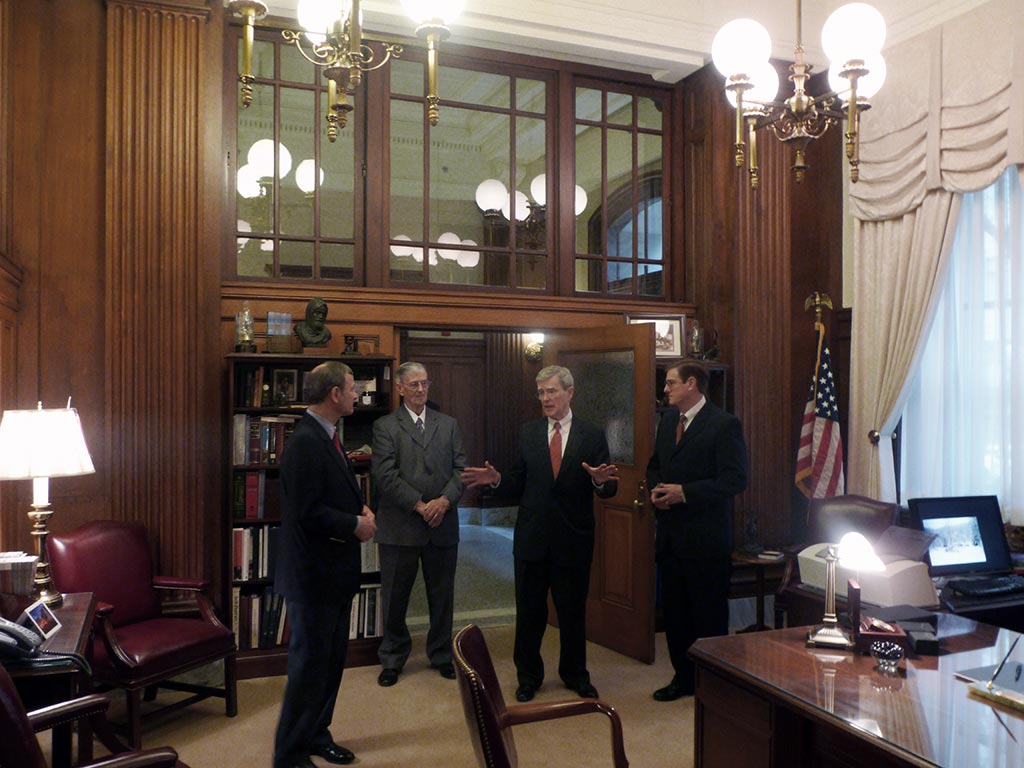
VISIT BY ASSOCIATE JUSTICE CLARENCE THOMAS
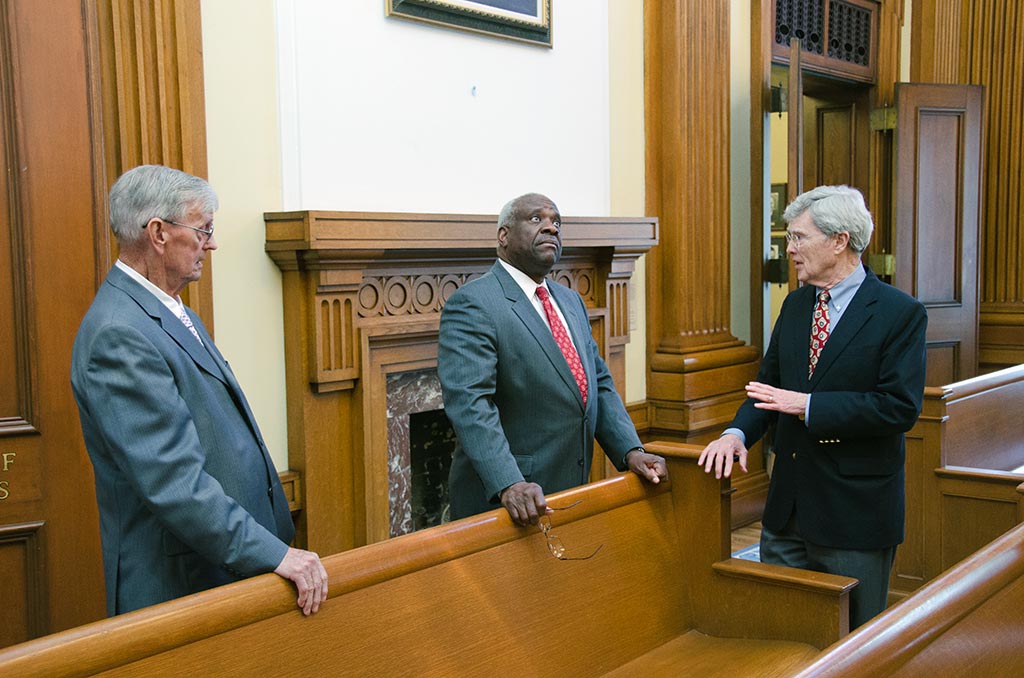
Supreme Court Associate Justice Clarence Thomas, seen here with Ninth Circuit Judges Edward Leavy and Diarmuid O’Scannlain, visits Pioneer Courthouse. In this photo, Justice Thomas surveys the courtroom. Justice Thomas also spent time at the University of Portland, meeting with students and faculty.
2014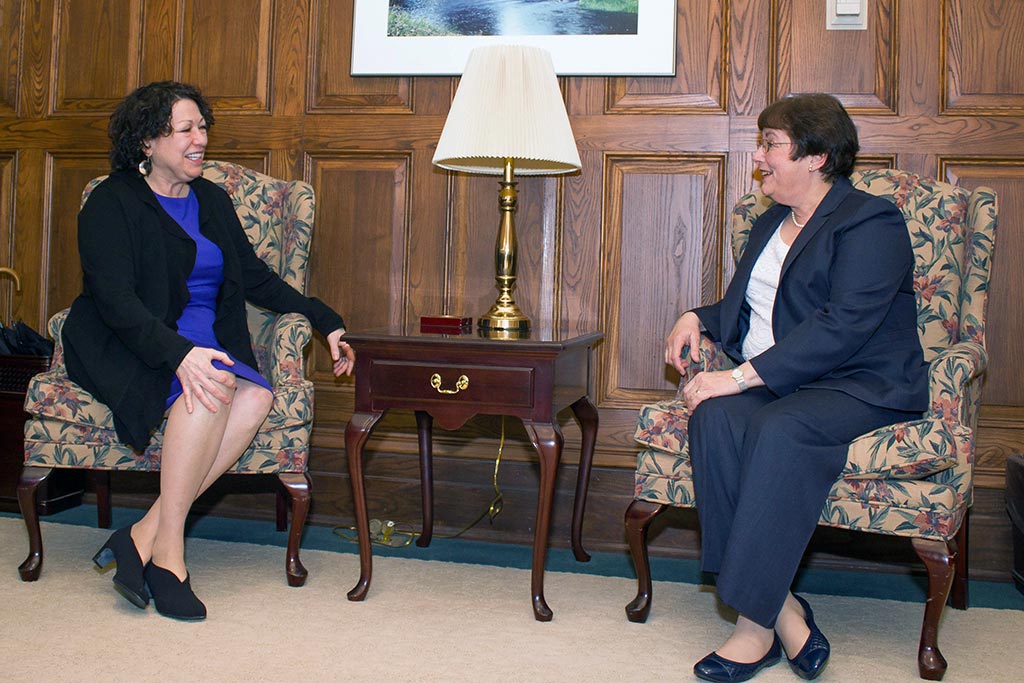
VISIT BY ASSOCIATE JUSTICE SONIA SOTOMAYOR
Supreme Court Associate Justice Sonia Sotomayor, seen here with Ninth Circuit Judge Susan Graber, visits Pioneer Courthouse and meets with judicial law clerks and staff.
PRECIPITATING THE OCCUPATION OF THE WILDLIFE REFUGE
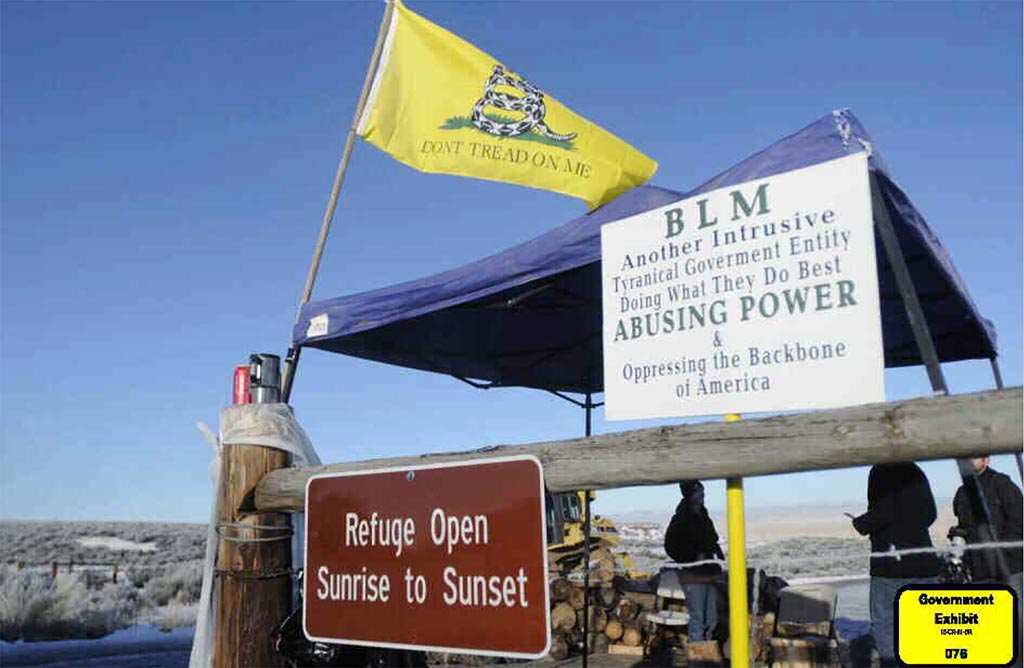
In United States v. Hammond, the Ninth Circuit Court of Appeals vacates the district court’s imposition of a sentence on defendants Steven and Dwight Hammond, because the term of imprisonment was shorter than the congressionally mandated five-year minimum, and remands for resentencing. Some people who disagreed with how the case was handled stage a multi-week protest in 2016 at the Malheur National Wildlife Refuge in Burns, Oregon.
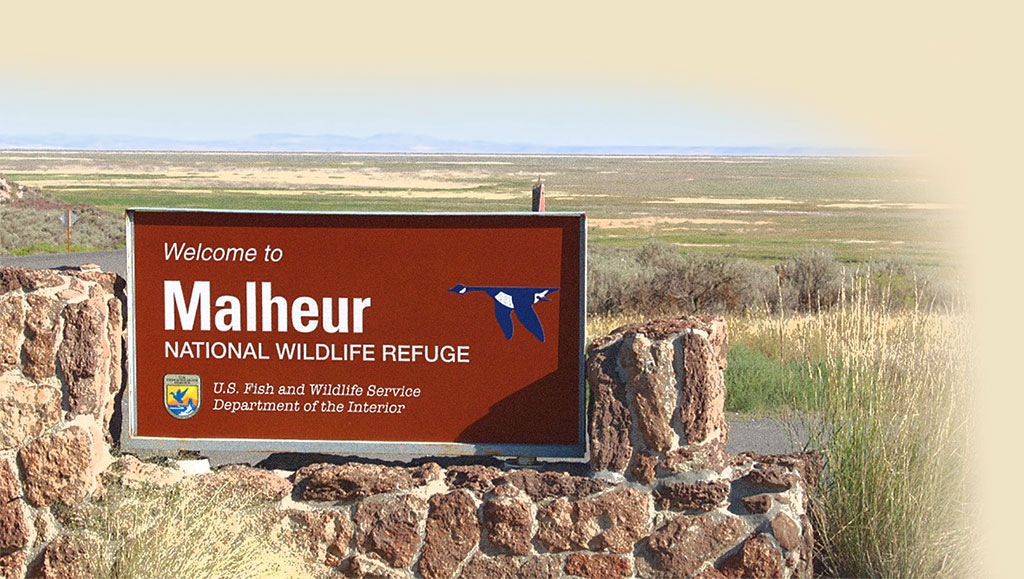
2015
DEVITT AWARD GIVEN TO NINTH CIRCUIT JUDGE
Ninth Circuit Judge Edward Leavy receives the 2015 Devitt Award, considered the “Nobel Prize” for members of the federal judiciary. Dwight D. Opperman, chairman of West Publishing Company, created the Devitt Award in 1982 to bestow a high honor to an Article III federal judge for distinguished and exceptional service. Opperman named the award after his esteemed friend, Judge Edward J. Devitt, who epitomized the highest standards of the federal bench. The Devitt Award is the longest-running and most prestigious award for Article III judges. The award ceremony is held in the Supreme Court building. In the photo below, left to right:, Justice Anthony Kennedy, Justice Clarence Thomas, Chief Justice John Roberts, Mrs. Julie Opperman, Judge Edward Leavy, Mrs. Eileen Leavy, and Justice Sonya Sotomayor.
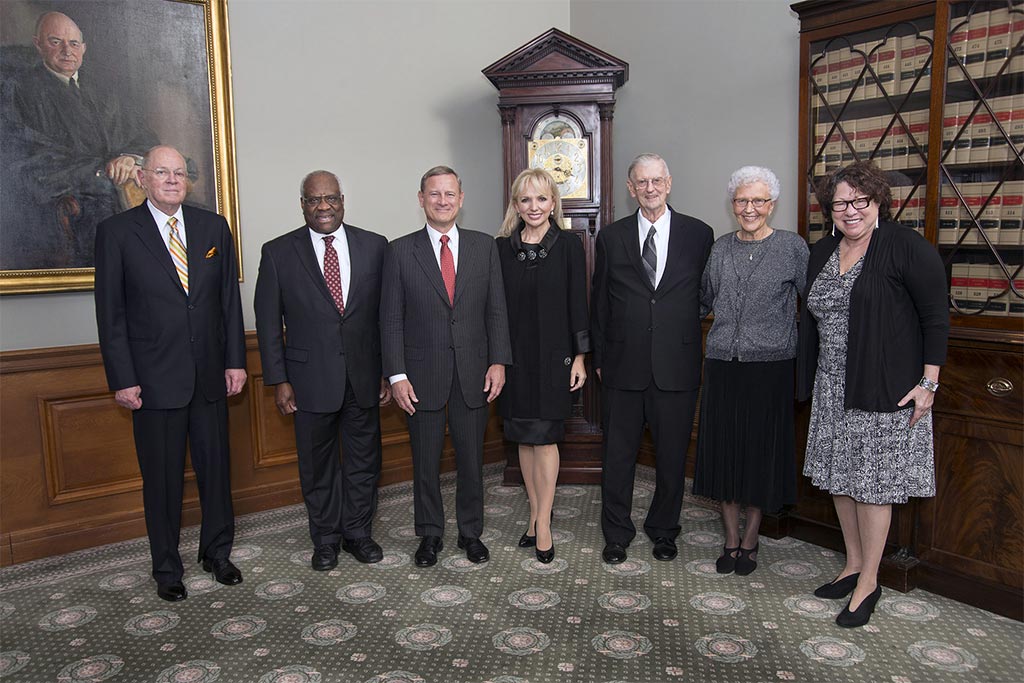
2018
INDIAN TREATY RIGHTS
In United States v. Washington, the Ninth Circuit Court of Appeals orders the State of Washington to replace more than 800 culverts under state roads at an estimated cost of $2 billion. Critics contend the court has handed tribes a precedent for challenging dams, restricting farming and altering century-old water rights. The next year, an equally divided Supreme Court upholds the decision, heralded by Northwest tribes.
2019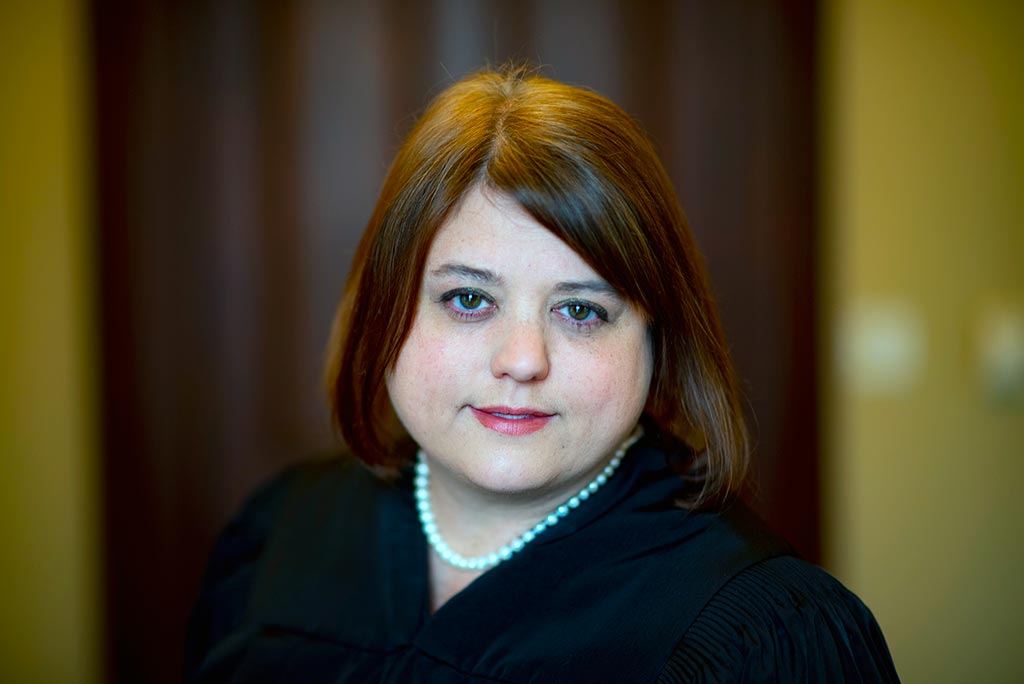
JUDGE DANIELLE HUNSAKER
President Donald J. Trump nominates Washington County Circuit Judge Danielle Hunsaker to succeed Judge Diarmuid O’Scannlain, for whom she had clerked a decade earlier, on the Ninth Circuit Court of Appeals. The U.S. Senate confirms the nomination by a 73-17 vote in November.
Back to top
 1824
1824
 The nation’s 94 judicial districts are organized into 12 regional circuits, each of which has a court of appeals. The United States Court of Appeals for the Ninth Circuit hears appeals from the district courts located within the vast Ninth Circuit as well as appeals from certain federal administrative agencies. The court reviews the decisions and records of proceedings from the district courts. The Ninth Circuit Court of Appeals is one step below the United States Supreme Court. The Ninth Circuit’s history reflects the history of America’s development as a nation and its westward movement.
The nation’s 94 judicial districts are organized into 12 regional circuits, each of which has a court of appeals. The United States Court of Appeals for the Ninth Circuit hears appeals from the district courts located within the vast Ninth Circuit as well as appeals from certain federal administrative agencies. The court reviews the decisions and records of proceedings from the district courts. The Ninth Circuit Court of Appeals is one step below the United States Supreme Court. The Ninth Circuit’s history reflects the history of America’s development as a nation and its westward movement. UNITED STATES CONSTITUTION
UNITED STATES CONSTITUTION



 PORTLAND NAMED
PORTLAND NAMED OREGON STATEHOOD
OREGON STATEHOOD
 PIONEER COURTHOUSE DESIGN
PIONEER COURTHOUSE DESIGN Construction commences on the Pioneer Courthouse as the Pacific Northwest’s principal federal office building. Immediately complaints begin about its distance from the downtown, which lies several blocks to the east and north. Portlanders, however, soon begin to take pride in the stately Italianate structure rising in what will before long become the heart of the city.
Construction commences on the Pioneer Courthouse as the Pacific Northwest’s principal federal office building. Immediately complaints begin about its distance from the downtown, which lies several blocks to the east and north. Portlanders, however, soon begin to take pride in the stately Italianate structure rising in what will before long become the heart of the city. 
 The Pioneer Courthouse is completed at a cost of $611,165. United States District Court Judge Matthew P. Deady moves into his spacious chambers and commences trials in the formal second-floor courtroom. With Supreme Court Justice Stephen Field and Circuit Judge Lorenzo Sawyer, Deady occasionally sits as a circuit judge, hearing appeals from district courts on the West Coast.
The Pioneer Courthouse is completed at a cost of $611,165. United States District Court Judge Matthew P. Deady moves into his spacious chambers and commences trials in the formal second-floor courtroom. With Supreme Court Justice Stephen Field and Circuit Judge Lorenzo Sawyer, Deady occasionally sits as a circuit judge, hearing appeals from district courts on the West Coast. PENNOYER v. NEFF
PENNOYER v. NEFF
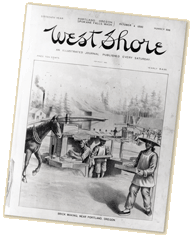 CHINESE
CHINESE 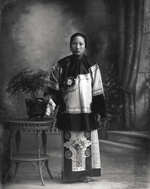 Responding to Oregonians’ and other westerners’ reactions to the arrival and labors of Chinese in the late-19th century, Congress passes the first of series of Chinese exclusion laws limiting, though not entirely prohibiting, the immigration of Chinese to America. Briefs testing the laws are filed in the courtroom of Judge Matthew P. Deady, who also sits on several circuit appellate Chinese exclusion cases with Supreme Court Justice Stephen Field, Circuit Judge Lorenzo Sawyer, and fellow district judges from other western states. Deady increasingly finds himself at odds with the Ninth Circuit’s jurisprudence on exclusion, which has a direct effect on restricting the arrival of Chinese in America in the late 19th and early 20th centuries.
Responding to Oregonians’ and other westerners’ reactions to the arrival and labors of Chinese in the late-19th century, Congress passes the first of series of Chinese exclusion laws limiting, though not entirely prohibiting, the immigration of Chinese to America. Briefs testing the laws are filed in the courtroom of Judge Matthew P. Deady, who also sits on several circuit appellate Chinese exclusion cases with Supreme Court Justice Stephen Field, Circuit Judge Lorenzo Sawyer, and fellow district judges from other western states. Deady increasingly finds himself at odds with the Ninth Circuit’s jurisprudence on exclusion, which has a direct effect on restricting the arrival of Chinese in America in the late 19th and early 20th centuries. 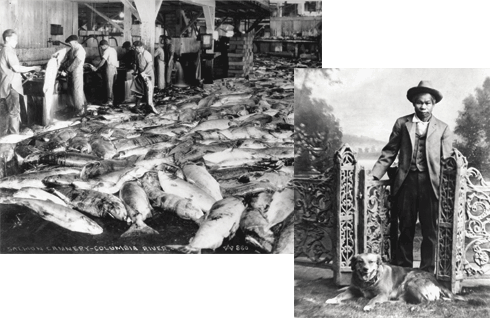







 In the 20 years between 1892 and 1912, a collection of larger, yet architecturally distinct, buildings rise around Pioneer Courthouse. The courthouse now sits in a canyon of terra cotta buildings that, while manifesting the popular City Beautiful movement of this time, hide the once-prominent landmark and cut it off from its famed views of the river, mountains, and the surrounding cityscape.
In the 20 years between 1892 and 1912, a collection of larger, yet architecturally distinct, buildings rise around Pioneer Courthouse. The courthouse now sits in a canyon of terra cotta buildings that, while manifesting the popular City Beautiful movement of this time, hide the once-prominent landmark and cut it off from its famed views of the river, mountains, and the surrounding cityscape. PIERCE v. SOCIETY OF SISTERS
PIERCE v. SOCIETY OF SISTERS












 Northwest Indian tribes and the federal government share a long and troubled history relating to Indian fishing rights, a story that continues to be written in the Ninth Circuit. District Judges Robert Belloni (Sohappy v. Smith, 302 F. Supp. 899 [D. Or. 1969]) and George Boldt (United States v. Washington, 384 F. Supp. 312 [W.D. Wash. 1974]) reaffirm the federal government’s guarantee to northwest Indians the right to fish "at all usual and accustomed places." The Ninth Circuit Court of Appeals is asked to balance fishing rights with environmental and other concerns in a series of cases that continues today.
Northwest Indian tribes and the federal government share a long and troubled history relating to Indian fishing rights, a story that continues to be written in the Ninth Circuit. District Judges Robert Belloni (Sohappy v. Smith, 302 F. Supp. 899 [D. Or. 1969]) and George Boldt (United States v. Washington, 384 F. Supp. 312 [W.D. Wash. 1974]) reaffirm the federal government’s guarantee to northwest Indians the right to fish "at all usual and accustomed places." The Ninth Circuit Court of Appeals is asked to balance fishing rights with environmental and other concerns in a series of cases that continues today.







